The story of the post-BR era's first new trains, in their initial ten years.

At Tyseley station on 28th April 1999, 168003 models the original Class 168/0 livery with non-contrasting doors.
It appeared that, had they not made history as the first post-British Rail motive power to enter service, the Class 168 'Clubman' units would have received no more than a pictureless footnote in the late '90s magazines...

The updated, post-2003 version of the Chiltern white/blue Class 168/0 livery, with contrasting doors, seen on 168005 at Bentley Heath, 12th July 2006.
BACKGROUND
The 168s' grand entrance came at a time when the magazines were overwhelmed with demand for coverage of the huge but imminently endangered stocks of ex-BR freight diesels. And even in their moment of historical achievement, the 168s were wildly overshadowed by the EWS Class 66s.
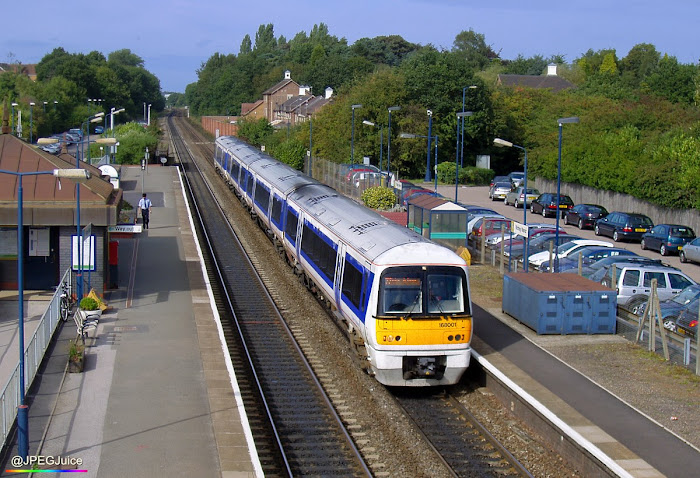
168001 - the history-making train that beat the first Class 66 into service by one week.
168001 beat 66001 into service. Only by seven days, but a first is a first, and Chiltern Railways' pride and joy was treated like an also-ran. While the 66 attracted an almost minute-to-minute commentary, the 168 got a quick flash of spotlight and then a wall of silence. Only to be expected, since the 168 was a multiple unit coming in as little more than a prototype, and the 66 was a volume-ordered locomotive that threatened to dismantle the entire kingdom of ex-BR freight diesels. But a snub to the 168's importance nonetheless.

Still firmly in the era of Kodachrome film, 168004 represents the classic, early 168/0 four-car look with non-contrasting doors, at Hatton. Four-car with original doors only lasted from late summer 1998 to summer 2000.
Even before going into service, the 'Clubman' had a historical significance. The wranglings of privatisation had frozen out all new UK train orders for nearly three years after BR set the Class 365 deal in motion in 1993. The Class 168 order was the action that finally ended that infamous 1,064-day dry spell.
Although the 168s were ordered by Chiltern and delivered to Chiltern, the initial batch of five units stands as a fascinating overhang from British Rail design standards. They look like a BR train, and nothing else delivered to a post-BR operator came with that same 'legacy' aura.
ENTER THE 'CLUBMAN'

An early shot of 168002, back in the late 1990s at Dorridge.
The testing programme for 168001 was scheduled to begin in January 1998, but after various delays the gleaming white and blue apparition popped out of Adtranz and started milling around Derby in mid April. It then pitched into its main line testing phase on the 23rd of the month, on the MML. 66001 was already off the boat and into its own regime of prep by then.
But things began to motor once the 'Clubman' showed its mettle on the main line, and 168001 was released to Chiltern in less than a month, on Monday 18th May 1998. After some preparation the new unit attended a press preview at Banbury on Monday 25th May, and commenced full service the next day on the 08:30 Snow Hill - Marylebone. 66001 made its first revenue-earning journey on 2nd June.
In fact, the 66 could have been first into traffic. If GM's class pioneer had been shipped from Canada on a fast crossing as originally planned, it would almost certainly have stolen the title of "first post-BR motive power to work a service". But the cost of the fast crossing rose sharply at the last minute, and EWS withdrew, opting to send the loco over on a vastly slower journey, which delayed UK arrival by nearly two weeks.
INSTANT THUMBS-UP
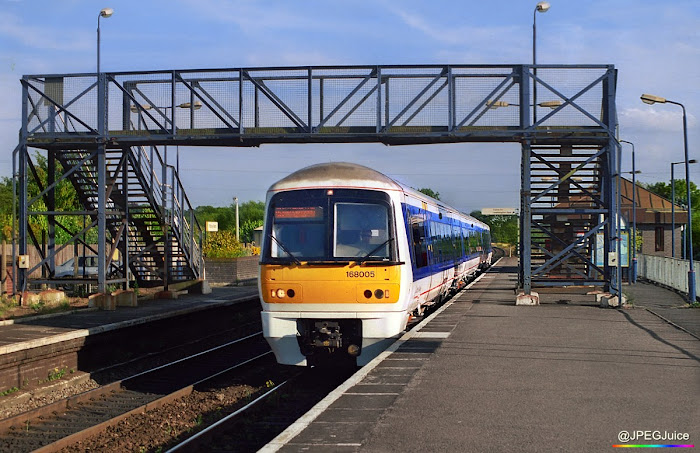
Running as a three-car set on 15th July 1999, 168005 heads for Birmingham through Widney Manor station. This old footbridge at Widney was removed in the mid 2000s, and a sturdier one was installed at the south end of the station, with the opposite orientation for the steps.
Loved by passengers, the Aylesbury-based Class 168s hit the network with both looks and performance. Trips from Birmingham to London on the new, air-conditioned, 100mph 'Clubman' instantly gained a rep for being smooth, comfortable, and on non-stop services, competitively fast. With modest fares available, and a much nicer route than the Euston line, the benefits of the service spread by word of mouth.
The first five Class 168s went into service as three-car sets, with upgrade to four-car status rolling out from late summer 1998. The only problem now was that there were too few of them. That was easy enough to solve though...
CLASS 168/1

On 22nd June 2001, before the redevelopment of the area, 168106 visits Birmingham Moor Street station. The new Bull Ring Centre, which had not at this point been built, rose rapidly over the next two years and opened in September 2003. The old Moor Street station, still run down and almost obscured by trees in this shot, was renovated at the same time.
The Class 168/1s were ordered in two batches - the first of which numbered five sets, and hit the Adtranz order books in 1998. As the first batch - 168106 to 168110 - were advancing through production in winter 2000, Chiltern ordered the other three 168/1s. The extras - 168111 to 168113 - could be added to the in-progress production run for delivery shortly after the last of the initial five, commencing late September 2000. As it turned out, they were delivered in continuum, and looked like one eight-strong batch. But they weren't. They were two separate orders.
The 168106 to 168110 batch had been ordered as two-car sets. However, by the time the trains were in production, needs and perceptions had evolved, and it was decided that each 168/1 from this group should be supplemented with one coach from a four-car 168/0 after delivery. The 168111 to 168113 batch were ordered as three-car sets.
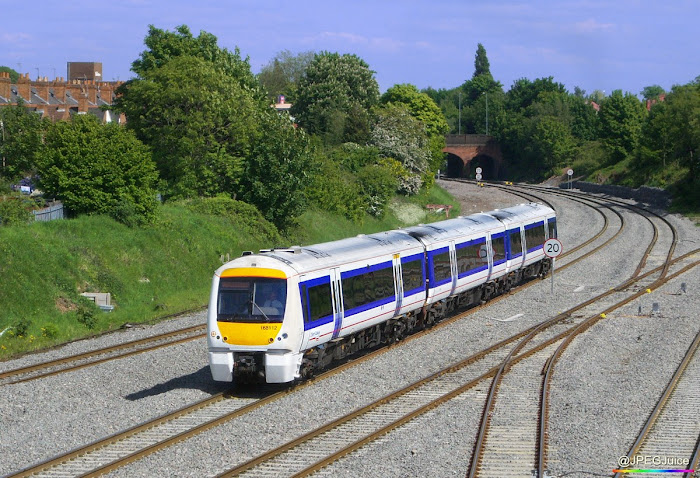
After refurbishment in spring 2008, 168112 reaches Tyseley en route from London to Birmingham. An easy way to identify these refurbished 168/1s externally was by the 'lips' that were added round their tail lights on the yellow cab front section.
It was still not known by the railway press in early 2000 that the forthcoming 168s would be classified 168/1, or that they'd differ in design from the 168/0s. RAIL magazine did not report until its 19 April - 2 May 2000 issue that the next deliveries would follow the front end appearance of the Class 170 and were "expected to have a different sub-class - 168/1s".

The first Class 168/1 - 168106 - test-ran from Adtranz Derby to Aylesbury on 11th June 2000, and was offcially released to Chiltern on 19th June. It's seen above in almost brand new condition at Birmingham Moor Street, alongside Central Trains' 150018, that summer.
Even setting aside the obvious difference in the cab design, the livery application was modified for the 168/1s. From new, the 168/1s featured accessibility-contrasted passenger doors, markedly interrupting the bodyside theme. The 168/0s were delivered with no accessibility markings, and had, up until this point, only been updated with small yellow identifiers at the top of each door.
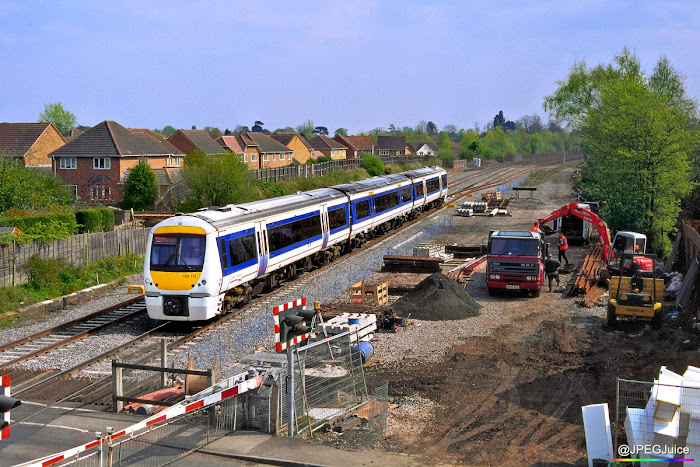
A rare shot showing 168111 on 19th April 2002 with an alien centre car. The vehicle has evidently come from a 168/0, since only the 168/0s ever had non-contrasting doors. Remember, 168111 to 168113 were built as three-car units, so this blag from a 168/0 would have been a temp replacement measure.
The introduction period for the 168/1s spanned across the major open weekend at Old Oak Common on 5th and 6th August 2000, and the then newest of the trains - 168109 - attended the event as a celebrity guest. But even this early in its life it was no longer as new. I'd photographed it working an 09:53 (1Z18) Adtranz Derby to Marylebone mileage accumulation journey on 19th July. On that date it was in as-built format with just two cars. But by Saturday 5th August when it appeared at Old Oak Common, it had been augmented with car 58454 from 168004.
When the 168/0 cars were migrated to the 168/1s, their numbers were changed to integrate with the new set. 58454 was thus renumbered 58659.
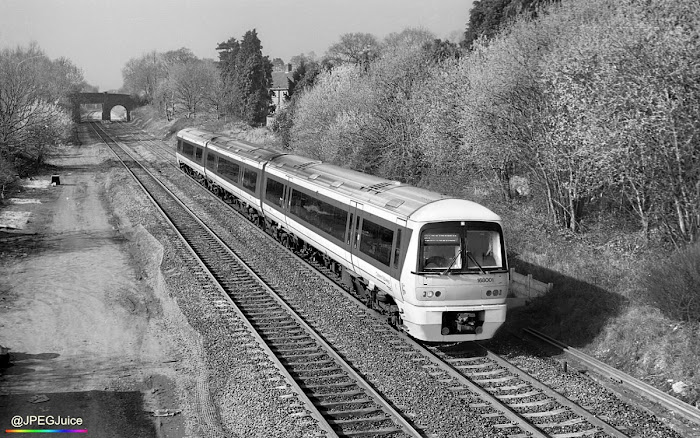
168001 seen as a three-car set in early spring 2002, after donating its fourth car to 168106. The fourth vehicle would be returned later in the year.
The fourth cars were removed from the 168/0s sequentially, based on unit number, so 168001 was robbed first, in late June 2000, to augment 168106. The 168/0 cars had to be modded before incorporation into the 168/1s, since, for one, they still had non-contrasting doors and so would not aesthetically match the rest of the train. The modifications took a number of days, so the transfers were not instant.
INTERIM PROJECTS

There would be a longer delay before the next batch of full-train builds began. Chiltern had two interim projects to sort out first...
1. Acquisition of additional vehicles which would allow restoration of the 168/0s to four-car status. Deliveries of the extra coaches began in summer 2002, and the fleet revisions were quickly completed. Chiltern opted to assign the original Class 168/0 coaches back to their designated sets, which meant taking them out of the 168106 to 168110 batch. The brand new coaches were then allocated to 168106-168110.
Since the door aesthetics of the five 168/0 cars had been updated when they were robbed from the original sets and added to the 168/1s in 2000, and the remnant three-car 168/0s had still not gained contrasted doors by 2002, the restored coaches did not now visually match their sets. This was not initially addressed. From late summer 2002, each 168/0 operated with three original liveried vehicles, and a single one with contrasted doors. This situation lasted until 2003, when all non-contrasted vehicles (i.e. three quarters of each 168/0) were finally updated with full accessibility-design passenger doors.
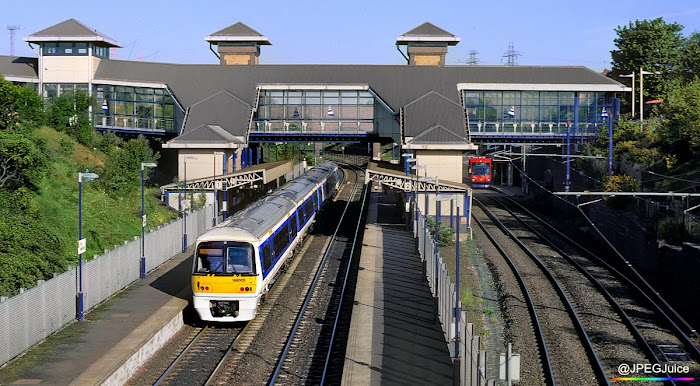
In a scene from The Hawthorns station, West Bromwich, on 15th May 2003, 168005 can be seen to harbour a non-matching third coach, with contrasting doors. Chiltern had introduced these London to Kidderminster services the same day Virgin launched Operation Princess - 30th September 2002. Virgin's publicity hugely overshadowed the Chiltern inauguration, but by this time in 2003, the Virgin scheme had already collapsed.
To clarify, generally speaking the 168/0s were three-car units from introduction in spring 1998 until latter 1998. They were then four-car sets until mid 2000. Then three-car sets again until late summer 2002, after which they once again became four-car sets. I say "generally speaking", because a coach with a problem could sometimes be removed for attention, leaving the train one vehicle short.
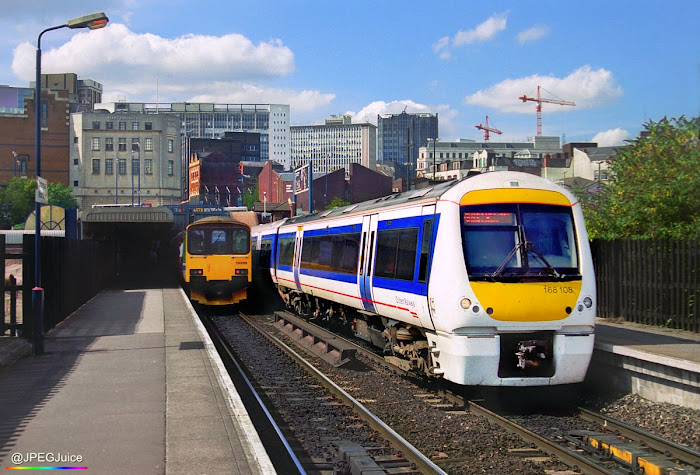
In the above photo of 168108 at Moor Street on 21st August 2002, you can, if you look at the roof, see the tell-tale sign that it has its brand new centre car - 58458. Three of these vehicles had just been released from Derby and incorporated into units 168107, 168108 and 168109. 168106 and 168110 were still waiting for their switches.

Chiltern white/blue 165035 with like-liveried 168106 at Dorridge.
2. Pilot work for a Class 165 refurbishment programme. This involved trial modifications to guinea pig 165013, and assessment through 2001 and 2002. The culmination was a refurb template which saw 165036 debut as the first full refurb in mid January 2003, with the Chiltern livery. That marked the start of Class 165 refurbishment, which brought the installation of air conditioning, revised, 'one-class-fits-all' seating in keeping with the Chiltern ethos of high quality travel as standard, security features, better disabled accommodation, modified front end with new lights and digital route display, etc.
THE CLASS 168/2

With refurbishment of the 165s underway, delivery of the first batch of 168/2s began in the first half of 2003. This order comprised four units - numbered from 168214 to 168217 - and all except 168214 had gone into traffic by May 2003. '214 joined its classmates in the June.
The 168/2s were similar in look to the 168/1s, but not the same. Whereas the front end of the 168/1 followed the styling of the original Midland Mainline Class 170/1, the front end of the 168/2 followed the later styling of the Porterbrook demonstrator Class 170/3.
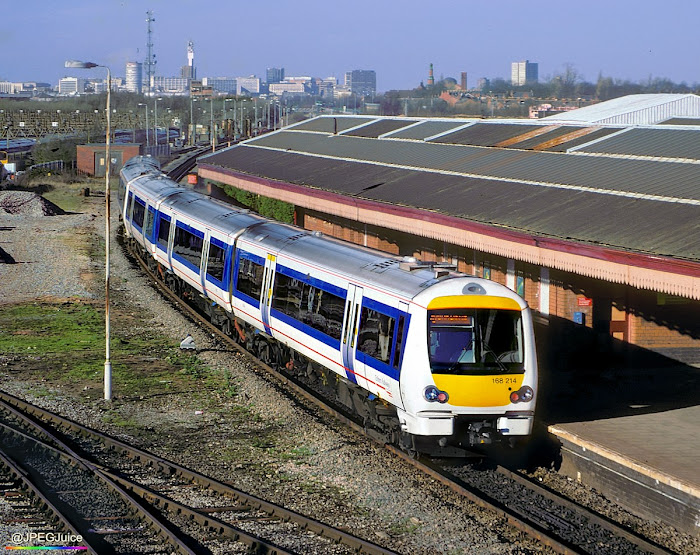
Still in its first year of service, 168214 takes a power break at Tyseley station on 25th January 2004.
The main difference lay in the fairing below the cab front, which on the 168/1 and 170/1 extended right down to just above rail level and was basically a full area cover with a cut-out for the coupling. On the 168/2 and 170/3, the fairing was really just two buffer sections. Especially given the white livery, this had a major impact on the look of the two 168 subclasses. There were other external differences too - most noticeably in the roof detailing.
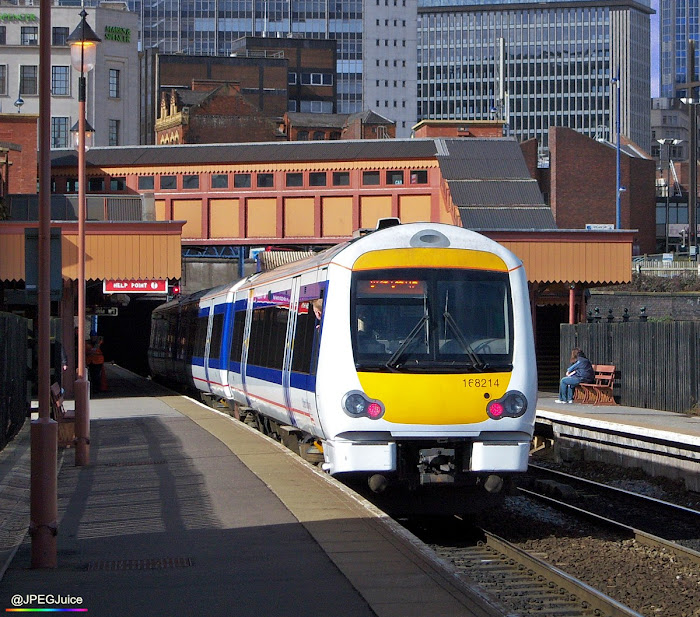
Here in March 2008, Birmingham Moor Street has a markedly different look from that of the early 2000s. This is 168214 bound for Snow Hill.
All of the Class 168/2s were introduced as three-car units, although early on you might catch the odd one working as a two-car. All of the 168/2s, including the final two 2004 deliveries - 168218 and 168219 - retained the three-car format until 2006. 168215, 168216 and 168217 were then expanded to four-car capacity, while 168214, 168218 and 168219 maintained their original composition. Although this doesn't pan out with much logic numerically, the sets updated to four-car capacity were the first three to be delivered.
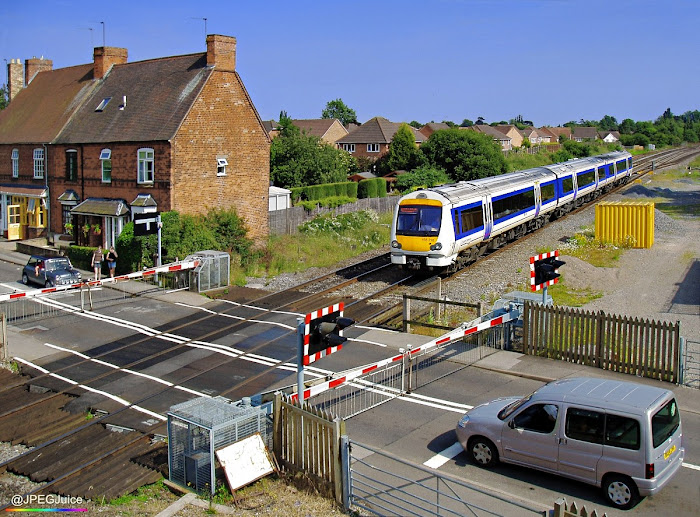
Ah, the fun you could have with photo angles at Bentley Heath crossing before the view was destroyed with traffic monitoring poles. This is 168216 in its original three-car formation on 28th June 2005.
AND INTO THE FUTURE
Aside from the number of cars, the mods to the Class 168/0 doors, and one or two other minor tweaks like the removal of the fairing section beneath the coupling on some 168/1s, the units remained externally as delivered until late 2007. There then began some refurb work, which was most noticeable externally on the 168/0s, since their front end livery design was revised. The work was mainly carried out in the first half of 2008.

Originally, the 168/0s had featured no yellow above the window base level on the cab front, and the window surround had been black. But by 2008, the sub-class had received a new design with a thinner black section contained within what was essentially now a full yellow end. You can see the revised design above, on 168001, approaching Bentley Heath on 21st May 2008.

It wasn't only the livery that differed at the front end. Eagle-eyed enthusiasts would also spot that a couple of lights per end had been removed, the section of fairing below the coupling had gone, and the font of the set number had changed. Check out 168002 above, passing Streetsbrook Road, Solihull, on 16th June 2010.

By the time of this refurb in 2008, the 168/0s were ten years old, and no longer in early life. They would, like their sister subclasses, subsequently receive the silver Mainline livery for a more modern image. But did they look as good as they had when making their debut in that simple, classic, Chiltern white and blue?...
